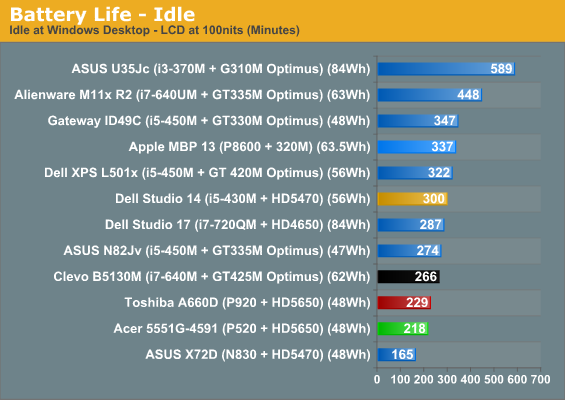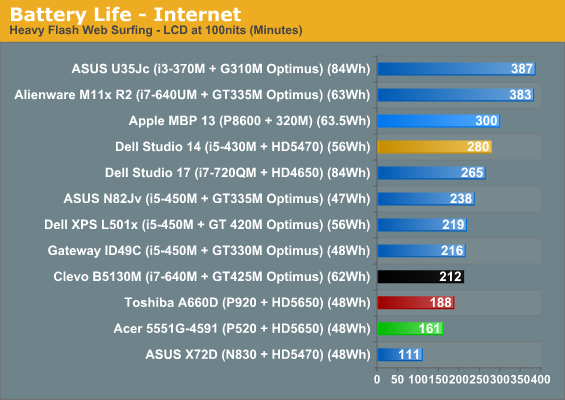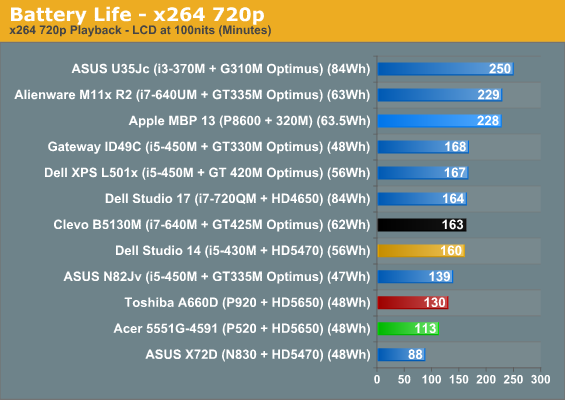Acer's Aspire 5551G: AMD's Budget Gaming Laptop
by Jarred Walton on November 27, 2010 12:00 AM ESTBattery Life
We've run our usual gamut of battery tests, and here the 5551G clearly falls short of the competition. Toshiba and HP both have AMD laptops with switchable graphics, and shutting off the HD 5650 dGPU on the Toshiba A660D looks to improve battery life by perhaps 18% in our best-case result. That's actually not as large a gap as we expected, but the results that really hurt AMD all come from Intel laptops—with or without dedicated graphics. Here's a look at some of the latest laptops and how they compare to the 5551G.





Idle battery life is the optimal result you can get, and we've even removed "unnecessary" applications and utilities so we're running a clean setup with no firewall or anti-virus software. In such a configuration, the 5551G nets just over 3.5 hours of battery life. That's not horrible, considering the paltry (but typical) 48Wh battery, but the problem is with Internet usage—a far more realistic scenario. Here the 5551G drops to a bit more than 2.5 hours, and for movie playback it just misses the two hour mark. It's not the end of the world, but without the use of AMD's IGP we're certainly not going to catch Optimus-enabled laptops.
If we compare with the older Acer 5740G (which was likewise discontinued far too quickly for our likes!), battery life is generally a wash. The 5740G had slightly lower idle and Internet battery life but tied in x264 battery life. As another comparison point, Dell's Studio 14 with an Intel CPU and a discrete GPU (granted, it's a slower HD 5470 GPU) manages five hours of idle battery life and 4.5 hours of Internet use, though it also suffers in the x264 test with a result of just 2.5 hours. If we account for the larger 56Wh battery in the Studio 14, Intel's platform with HD5470 is still leading the AMD P520+5650 by 18-49% depending on workload. How much of that comes from the difference in GPU? It's tough to say for sure, but we suspect Dell may have spent a bit more time optimizing for battery life.
Ultimately, when we factor in the much higher CPU performance that Core 2010 offers relative to AMD's processors, it's easy to see why most laptop manufacturers aren't keen on shipping us AMD-based laptops. If you want performance, Intel's Core 2010 parts win easily; Intel also dominates in performance per watt (ULV) and pure battery life (Atom). But then, AMD wins with a better IGP and typically far more affordable prices (outside of Atom netbooks, which we're not too keen on anyway). Hopefully all this will change when we start to see the next generation CPUs from AMD—all those Bulldozer, Bobcat, Zacate, Brazos, Ontario, Llano, etc. codenames we periodically discuss. Where will those solutions fall in the pantheon of laptops? We'll have to wait and see, but with power gating and other enhancements we should see much better battery life from AMD next year.
Temperatures and Noise
Temperatures are quite good, with both the CPU and GPU topping out at around 65C—well within margins for mobile chips. The hard drive likewise stays at a consistent temperature. Again, we don't know exactly where HWMonitor gets the power information, but it's interesting to see a maximum power draw of 20W for the P520, with a minimum power draw of only 3.15W. That's quite good and would make for much better battery life; unfortunately, the chipset, discrete GPU, and other components appear to be consuming the lion's share of the power. At idle, the laptop bottoms out at around 13W of power use, which is almost 3W higher than the Dell XPS 15 with Optimus.
Noise levels are actually very good for a midrange 15.6" laptop—some of the lowest we've measured. Idle noise measures 33dB and load noise topped out at 55dB. Considering the temperatures, the low noise levels are even more impressive.











36 Comments
View All Comments
TekDemon - Monday, December 6, 2010 - link
Acer notebooks are very obviously built to a price-point...they're the only company I know that'll actually ship laptops with only one speaker to save that extra dollar. I know that doesn't apply to the Timeline but there's still plenty of penny-pinching in the build.And it does matter since in reliability studies they don't fare all that hot compared to companies that put more effort into good build quality.
MadMan007 - Saturday, November 27, 2010 - link
I think it's interesting that much of the article, when talking about the laptop overall, goes on about pricepriceprice but then you want a better LCD too, and even quantify it to the opint that the pricepriceprice advantage would be washed out by a better LCD. Not that AT has as much pull as lame mainstream places like CNet, PCWorld etc but maybe if you started making it clear that better screens at a higher price is a good thing, rather than going back and forth between 'great price' and 'bad screen,' manufacturers might take note.JarredWalton - Saturday, November 27, 2010 - link
I didn't think I really said much about the LCD in this review. I mention it as being average in the intro, and I have our standard LCD test page where I show how it's no better than other budget laptop LCDs, There's definitely a place for good LCDs, but honestly putting a high quality LCD into an AMD-based laptop like this is pretty pointless. If you're willing to pay $100 more for a quality LCD, you'd probably want better build quality, better battery life, and a faster CPU as well -- all of which you can find in something like the Dell XPS 15.When we're looking at what is essentially a pure budget build, I'm okay with the mediocre LCDs; I don't like them, but I don't expect them to increase the cost by 15 to 25% just for the display. Basically, budget notebooks costing under $650 with standard LCDs is acceptable.
I think you're referring to the quote at the beginning, where I reference the Toshiba A660D conclusion. Keep in mind that the A665D/A660D originally cost over $800 (it's now $680 for the A665D-S6059 at Newegg), and at a price of $800 I expect a lot more. I suppose I could edit the quote, but I didn't want to do that. Hope that clarifies things a bit. :)
Stuka87 - Saturday, November 27, 2010 - link
The Hardware Monitor graphic is missing from page 6.Instead I just see: [HWMonitor]
JarredWalton - Saturday, November 27, 2010 - link
Fixed, thanks. I put that in as a placeholder (we add the text into the content engine and then add images) and missed replacing it. Oops.silverblue - Saturday, November 27, 2010 - link
Acer's best AMD model seems to be the 5553 which, despite not really being a step up, does offer switchable graphics. That in itself may gift it better battery life with that anaemic 48Wh battery.In any case, the CPU in the 5551 is a few months old now; it would be good if you could find a laptop with a Phenom II P650 (runs at 2.8GHz and sports a 25W TDP), though it's a new model so I doubt it's readily available.
KingstonU - Saturday, November 27, 2010 - link
Great job on the review, you guys cover and discuss all the aspects that I want to know about when shopping for this kind of laptop. I recently bought the TimeLineX which is almost this exact laptop but with Core 2010 CPU and a much bigger battery for $850 CA. Cures almost all of the problems with the model in the review. Very happy with my purchase and look forward to more laptops like this in the future.aylafan - Sunday, November 28, 2010 - link
While I do agree about the love/hate relationship with the keyboard and poor LCD screen. Overall, I still think the Acer's Aspire 5551G is better buy than the 5740G I owned before. Maybe, not in the processor department, but pretty much in everything else.I've played around with a similar Acer laptop model at Wal-mart and the build quality feels much better than the plastic gemstone design of the 5740G. The 5740G has poor battery life, it had an annoying beep each time I unplugged the power adapter, it weighed more than other laptops in its class, the Western Digital hard drive kept freezing so I had to install quietHDD, the touchpad buttons were stiff to push down, etc. There were just too many annoying things with the 5740G. All these flaws pretty much killed my expectations of the laptop.
Now, the TimelineX 4820TG is on a whole different level. I've had no problems with it and the build quality feels more sturdier than the 5740G that I owned before. It's given me around 6 hours of battery life. it's extremely thin, weighs only 4.65 lbs, has a Core i processor, it looks professional, it has switchable graphics, etc. and best thing is that it's only around $800. Here is my review. http://forum.notebookreview.com/acer/499204-acer-a...
While, you may argue that the TimelineX is just a better version of the Acer laptop you just reviewed. Every little improvement changes the whole experience.
Akaz1976 - Sunday, November 28, 2010 - link
Would love to see a Acer 3820TG-7360 (i3/HD5650/4GB/$700) review . Recently i have had good experience with acer sub-notebooks.Acer seems to be the only one targeting decent variety in optical drive-less (sub 4lbs) notebooks. I have an 1820tz which is awesome for what it does (essentially a netbook size/batterylife but basic laptop type power). Its great for wife/kids even work related travel. And for the price it only needs to last half as long as a 'business' laptop (to cost same amount annually).
The 3820 ( provides excellent portability and performance. Apparently (i have not received mine yet) it delivers 8hrs of battery life and <4lbs for travel (i can carry it at a conference for full day without having to have a powerbar or wreck my shoulder) yet i can play BFBC2 at medium in my hotel room in the evening.
Akaz
PS. I think laptop makers need to really evaluate the role of optical drive in modern always connected/Saas/USB key world. Even as a gamer i rarely need optical drive (bless steam). For work i have never need optical drive as everything is installed at the start (even then many software are downloaded rather CD installed). All it does is add cost and weight.
Dug - Sunday, November 28, 2010 - link
I just bought a timelineX 4820TG for under $790 and my only complaint would be the speakers. But at 4.5lbs and getting over 6hrs batter life, I can forgive this. The keyboard is not bad at all.I'm not sure why anyone would by this over the 4820TG. Plus I can overclock the video card without any problem and without any obnoxious noisy fans.